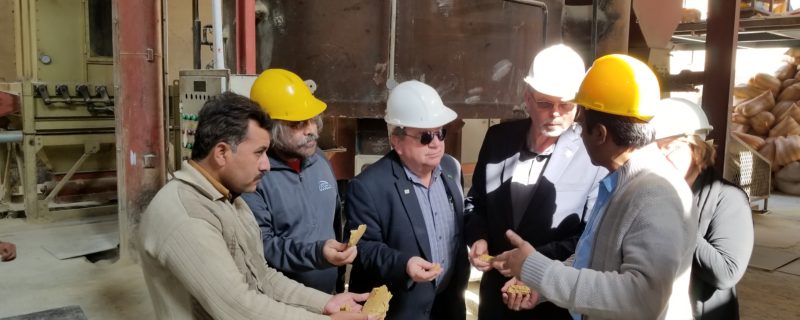U.S. soybeans accounted for 32% of imports to country in 2016-17.
January 12, 2018

Continuing the series of Asia subcontinent (ASC) market assessment trips, U.S. soy grower leaders John Motter, immediate past chairman of the United Soybean Board and chairman of the board's Strategic Management Committee, and Monte Peterson, director of the U.S. Soybean Export Council (USSEC) and American Soybean Assn., recently concluded a travel mission in Pakistan -- the first visit of U.S. soybean farmers to Pakistan. This visit took place after attending the Regional ASC Buyers Conference in Sri Lanka and visiting leading soy crushers and poultry customers in Bangladesh.
Motter, Peterson and acting regional lead-ASC Pam Helmsing attended the 2017 U.S. Soy Consultative Meeting, which was coordinated by R.S.N. Janjua, USSEC Country Representative – Pakistan. The audience was comprised of key buyers of U.S. soybeans, members of the All Pakistan Solvent Extractor Assn. (APSEA) and members of the Pakistan Poultry Industry.
Motter delivered an effective message about the U.S. soy industry from a grower’s perspective to the Pakistani audience. Peterson spoke about soy farming practices in the U.S., telling attendees how a superior commodity is produced from U.S. soy farms and supplied globally. Helmsing spoke about the U.S. soy advantage, which is recognized globally in developed and developing markets. Janjua provided a local perspective by detailing USSEC’s program in Pakistan and sharing important soy statistics. Shakil Ashfaq, convener, technical committee of APSEA, provided an overview of Pakistan’s oilseed industry and its preference for soybean imports.
About 20 key participants, including Ch. Ashraf, chairman of the Pakistan Poultry Assn.-Southern Zone; Fazal Ahmed, APSEA vice chairman, and other large importers of soybeans participated in the consultative mission to discuss the growth of soybean imports, their use in the country, challenges and issues. All of the buyers expressed great satisfaction over the quality of U.S. soybeans and trade friendliness.
Ahmed recognized that USSEC’s efforts and cooperation extended to APSEA to help improve the soy crushing industry and the tech and trade exposure they derive from USSEC’s global programs, such as the U.S. Soy Global Trade Exchange and industry visits.
APSEA has 71 members that account for an installed daily crushing capacity of 21,500 metric tons. Most of the new soy crushing plants are being erected at the Port Qasim Industrial Zone near Port Qasim and have larger capacities. The change, which reflects a higher scale of operations and technology adoption, is being linked to the knowledge and education USSEC has been providing recently.
The grower leaders also visited the Fauji Akbar Portia (FAP) marine terminal for bulk handling of grain and fertilizer. The facility has a transit storage capacity of 130,000 mt, including 72,000 mt in steel silos and warehouses with a pneumatic and mechanical unloading facility (1,600 tons per hour). The U.S. soy team inspected the bagging process and learned how U.S. soybeans are handled by FAP management. FAP noted that it prefers to handle U.S. soybeans because of their uniformity, low moisture and controlled foreign matter. They also had discussions about the cocklebur weed.
Pakistan imported 630,203 mt of U.S. soybeans in the 2016-17 marketing year, which ended in August, accounting for a 32% share from a total of 1.69 million mt of imported soybeans. The current season is off to a good start, with the country importing 334,420 mt of U.S. soybeans in September and October 2017.
“With a growing preference towards U.S. soy and the rapid expansion of the poultry industry, the country is likely to see an increase in U.S. soybean imports in the future,” USSEC said.
You May Also Like



